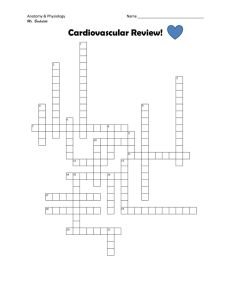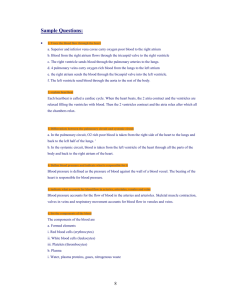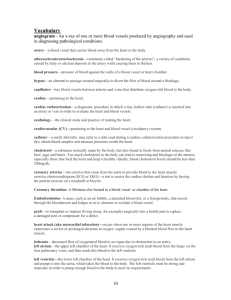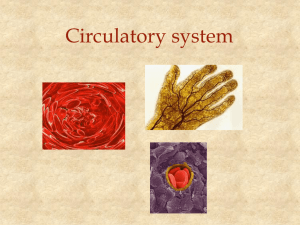circulatory system jeopardy
advertisement
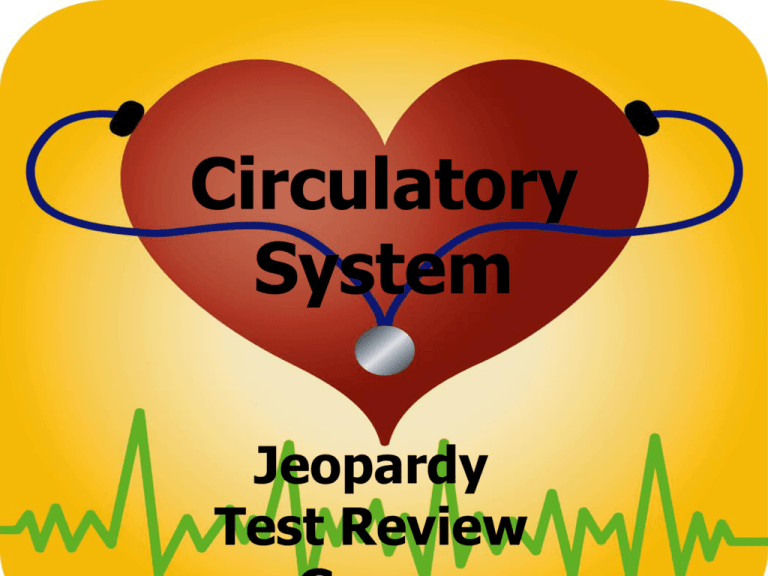
Circulatory System Jeopardy Test Review Blood Vessels Circulation Heart Blood Pressure Cardiovascular Disease 100 100 100 100 100 200 200 200 200 200 300 300 300 300 300 400 400 400 400 400 500 500 500 500 500 Which type of blood vessel is only one cell layer thick? capillary Which type of blood vessel measures the highest blood pressure? artery Which type of blood vessel contains a layer of smooth muscle? arteries and veins What type of blood vessel contains valves to prevent blood from flowing backwards? veins What type of blood vessel is the aorta? artery Name the three types of circulation. coronary, pulmonary, and systemic What type of circulation carries blood to the lungs? pulmonary circulation What type of circulation covers the largest area? systemic circulation What is the general pathway of blood’s circulation? heart→lungs→heart→body Coronary circulation provides blood flow to the __________. heart Name the four chambers of the heart. right atrium, right ventricle, left atrium, and left ventricle Which side of the heart contains deoxygenated blood? right side Why is the left ventricle larger than the right ventricle? The left ventricle is larger because it has to pump blood all over the body. (The right ventricle pumps blood to the lungs.) What part of the heart separates the right ventricle from the left ventricle? septum A(n) _____ carries blood away from the heart, and a(n) _____ carries blood to the heart. An artery carries blood away from the heart, and a vein carries blood to the heart. What is blood pressure? Blood pressure measures the force of blood on the artery walls. What does the systolic number measure? ventricular contraction What does the diastolic number measure? ventricular relaxation What is a sphygmomanometer? A sphygmomanometer is the instrument used to measure blood pressure. What is the scientific term for high blood pressure? hypertension What does cardiovascular disease affect first? heart and blood vessels What is atherosclerosis? Atherosclerosis is commonly called “hardening of the arteries.” It occurs when plaque builds up in the arteries and restricts blood flow. Name three things you can do to help prevent cardiovascular disease. eat healthy, exercise regularly, and do not smoke What numbers indicate a healthy (or average) blood pressure reading? 120/80 In the blood pressure reading 136/82, which number is the diastolic number and which number is the systolic number? 136 = systolic 82 = diastolic More Blood Blood Types MISC. Types of Tissue More Misc. 200 100 200 100 200 100 200 100 200 100 400 200 400 20 400 200 400 200 400 200 600 300 600 300 600 300 600 300 600 300 800 400 800 400 800 400 800 400 800 400 1000 500 1000 500 1000 500 1000 500 1000 500 Name the three cells (or cell fragments) that make up the solid portion of the blood. red blood cells, white blood cells, and platelets What is the liquid portion of blood? plasma What molecule on the red blood cell allows it to carry oxygen and carbon dioxide? hemoglobin What is the function of white blood cells? fight infection What cell fragment produces fibrin? platelets Name the four basic blood types. A, B, AB, and O What can happen if you mix incompatible blood types? blood clots and/or death A person with blood type Owants to donate blood. Which blood type or types could receive this blood? A, B, AB, and O (regardless of the Rh factor) A person with blood type B needs a transfusion. What type of blood can this person receive? B or O What kind of blood can be received by a person who is negative for the Rh factor? (Hint: positive or negative) only negative blood What did we say was the main job of the circulatory system? It transports. (oxygen, nutrients, carbon dioxide, wastes, etc.) What are the thread-like fibers that form a sticky net to trap escaping blood cells and plasma? fibrin Which type of blood cell is created at approximately the same rate as it is destroyed? red blood cells What type of blood cell often increases in number if you become sick? white blood cells How would you describe the blood that is carried to all the body organs? oxygenated blood What type of tissue makes up the fat around the heart? connective What type of muscle tissue makes up the ventricles of the heart? cardiac muscle tissue What type of tissue makes up most of the blood vessels? connective Arteries and veins contain a layer of ______ muscle tissue. smooth What type of tissue is blood? connective What is the main component of blood that is responsible for blood clotting? (hint: not fibrin) platelets Red blood cells carry _____ to the body. oxygen Put the following cells or cell fragments in order from least to greatest inside the body: RED BLOOD CELL WHITE BLOOD CELL PLATELETS White Blood Cells Platelets Red Blood Cells A person with a blood pressure reading of 150/110 would be suffering from ________. (hint: use the scientific word) hypertension What type of blood vessel is connected to each atrium? vein


